-
News & Trends -
Sales -
Marketing Related Topics -
B2B Software Guides Related Topics -
Free Tools & Resources -
- About Us About Us


A lead generation funnel maps a lead's journey from brand awareness to action and represents the systematic approach salespeople and marketers take to generate quality prospects. Lead generation funnels are therefore broken down into stages that mirror your unique lead generation process, with more qualified leads moving further down the funnel to the bottom. Leads who make it through your lead gen funnel are marked as prospects for further nurturing.
Effective lead generation funnels are usually divided into three broad parts — top-, middle-, and bottom-of-funnel — and help guide your manual outreach. At each phase, you identify a specific action leads must take to advance to the next step toward qualification. By breaking up the funnel into broad phases, you can monitor the number of high value leads in your pipeline and track the conversion rate of each funnel stage. Only a small percentage make it from top to bottom.
The awareness or discovery phase is at the top-of-funnel. The goal is to get your lead comfortable with your brand and build trust. The middle-of-funnel part is the interest and desire phase that typically comes when interested leads are exposed to your content or unique selling proposition (USP). Lastly, the bottom-of-funnel is the action and qualification phase. Here, leads take specific actions, like engaging with a lead magnet, and reps decide how to begin nurturing.
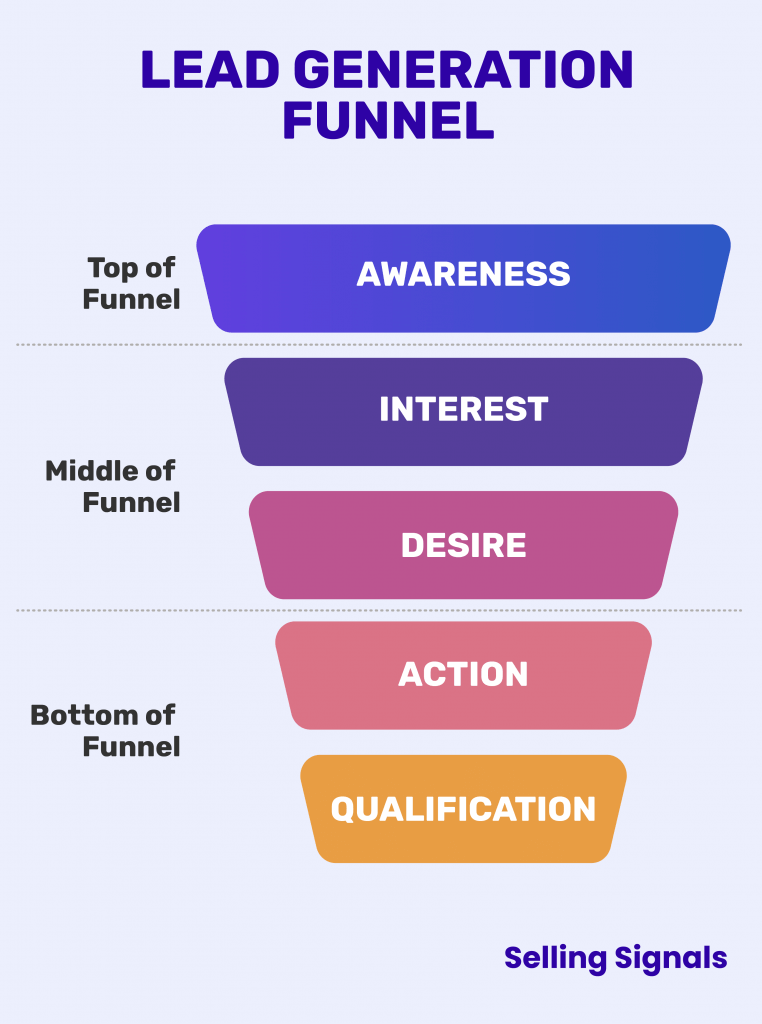
There are two main types of lead generation funnels you can create and optimize — online and outbound. To create your own funnel, first map the systematic stages necessary to move a lead from awareness to action. Then, identify the actions the lead must take at each step to move down the funnel, as well as the touchpoints necessary to spur them into action. With this in mind, let's take a look at the common lead generation funnel stages to help you get started.
As mentioned above, there are three main phases to help evaluate the effectiveness of your lead generation process — top-of-funnel, middle-of-funnel, and bottom-of-funnel. However, when mapping your own lead generation funnel, you can break it down further into five stages that better represent the lead journey from awareness to action. Let’s go over these stages and how leads move through each one:
These top-of-funnel leads have become aware of your brand. They’ve maybe read your blog post or liked one of your Instagram posts.
When a lead is qualified, they've left your lead gen funnel, and the next steps depend on your sales process. If you sell products or services that don’t need contact with a sales rep, marketing might nurture them via an automated email sequence. If you sell a B2B product or big-ticket consumer item, a salesperson might schedule a meeting. Or, to invest your time wisely, you might further qualify the lead before spending time selling them.
An online lead generation funnel maps a lead's online journey from awareness to conversion. Typically, awareness is generated through the creation and distribution of free content via social media platforms or search engines. Once interest and trust are built, leads are offered a valuable lead magnet in return for their contact details. From there, marketers typically qualify and pass the lead to a sales rep or conduct ongoing nurturing activities like email nurturing.
Here's an example of what an online lead generation funnel might look like:
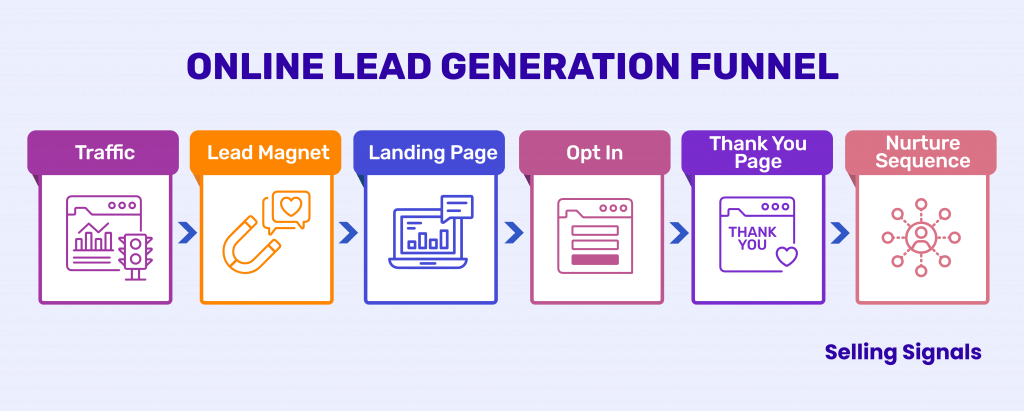
Let’s now go over each step to create your own online lead generation funnel in depth:
Your lead journey is the defined steps a person takes to become a qualified lead and the touchpoints required to move them through each step. These steps will become the specific stages of your lead generation funnel and outline the points of contact between a potential lead and your brand.
To map your lead generation funnel, do the following:
Each of these steps becomes a stage in your lead generation funnel. Once you've defined your stages, tangibly map them using lead funnel software or CRM software. This way, you can track and manage leads as they move through your funnel.
Now it’s time to create free content or paid ads that make your ideal customers aware of your brand and act as a gateway to the lead magnet you’ll create in step four. This content should be educational, helpful, and/or inspiring, and it must resonate with your target audience — if these leads like your content, they’ll continue consuming it, which will increase the chances that they’ll eventually want your lead magnet.
Here are some examples of free content you can offer:
Make sure you're sharing your free content on the platforms your ideal customer uses. Paid content, such as social media or pay-per-click (PPC) ads, can also be effective, as it can boost your brand's visibility and build awareness quickly. Regardless of the type of content you choose to create, the more you produce, the higher the chance you have of reaching your audience. Then, you can start planning out a lead magnet, or content upgrade, to promote along with it.
A lead magnet is a free asset that you offer along with — or within — your free and paid content. The lead magnet could be an ebook, guide, discount offer, free demo, or similar item. To receive the lead magnet, your audience must provide their contact information. When creating your lead magnet, make sure it's related to the awareness content you're promoting.
For this reason, it's important to plan your awareness content strategy in conjunction with your lead magnet. However, it's possible to create your lead magnet first before actually creating the awareness content that's supposed to promote it. This is especially important if you plan on using paid advertising to send a lead directly to your lead magnet.
Here’s an example of a lead magnet and how to present it well:
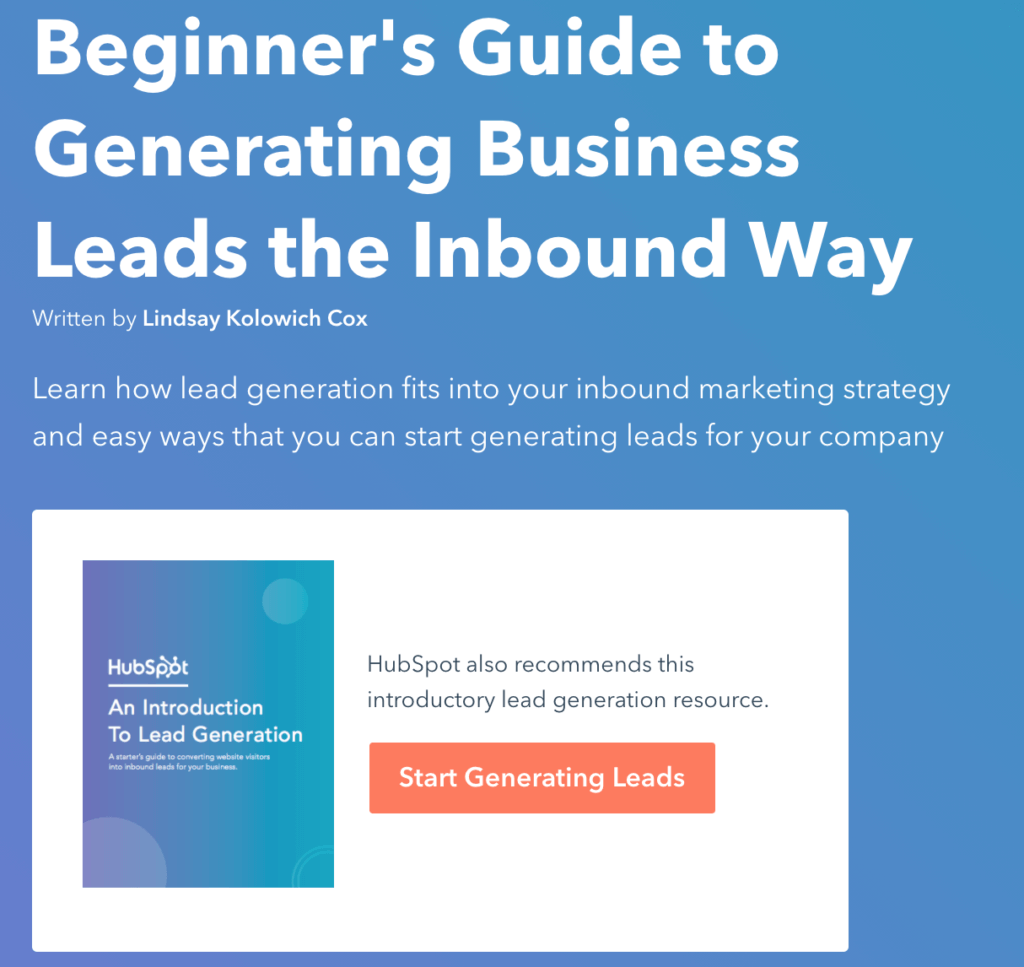
Read our article on how to create a lead magnet for a step-by-step guide plus templates and examples.
Once you create a relevant lead magnet, there are two primary ways to offer it to your audience: First, you can create a dedicated landing page with snappy sales copy and an embedded contact form. Second, you can use email capture forms embedded directly within the awareness content itself. There are benefits to both methods, and it might be a good idea to experiment with both.
Landing pages give you more room to explain the value of your lead magnet, and can also be used to promote directly on platforms like social media and Search. For example, you might share awesome free content on Twitter, and then once you build trust, share a direct link to your lead magnet. You can also use it to promote your lead magnet within your awareness content by linking to the page with a call-to-action (CTA).
The benefit of an embedded email capture form is that you can offer your lead magnet directly within your awareness content without forcing the lead to leave the page. This positions you as an expert in your field with high-value content and reduces the number of steps your lead must take. The downside, however, is that you can't share your lead magnet offering directly on platforms like social media when compared to a landing page.
To create a landing page or email form for your lead magnet, check out our articles on the best landing page builders and the best email capture software. You can also create lead capture forms directly on social media using Facebook lead ads and LinkedIn lead gen forms.
Here’s an example of how you might offer your lead magnet:

An opt-in form is the embedded form that users must fill out and submit to access the gated lead magnet. This opt-in form can live on a landing page or directly within your awareness content. In the form, include different fields like name, email address, phone number, job title, and/or any other information that will help you qualify the lead’s fit and conduct and personalize your sales messaging later on.
However, you want the opt-in form to be an easy and quick experience for the visitor, so designing a clean form layout and limiting the number of fields to only necessary ones is crucial. Your landing page builder or email capture software should help facilitate this form creation.
Here’s an example of an opt-in form that pops up from the landing page in the previous step:
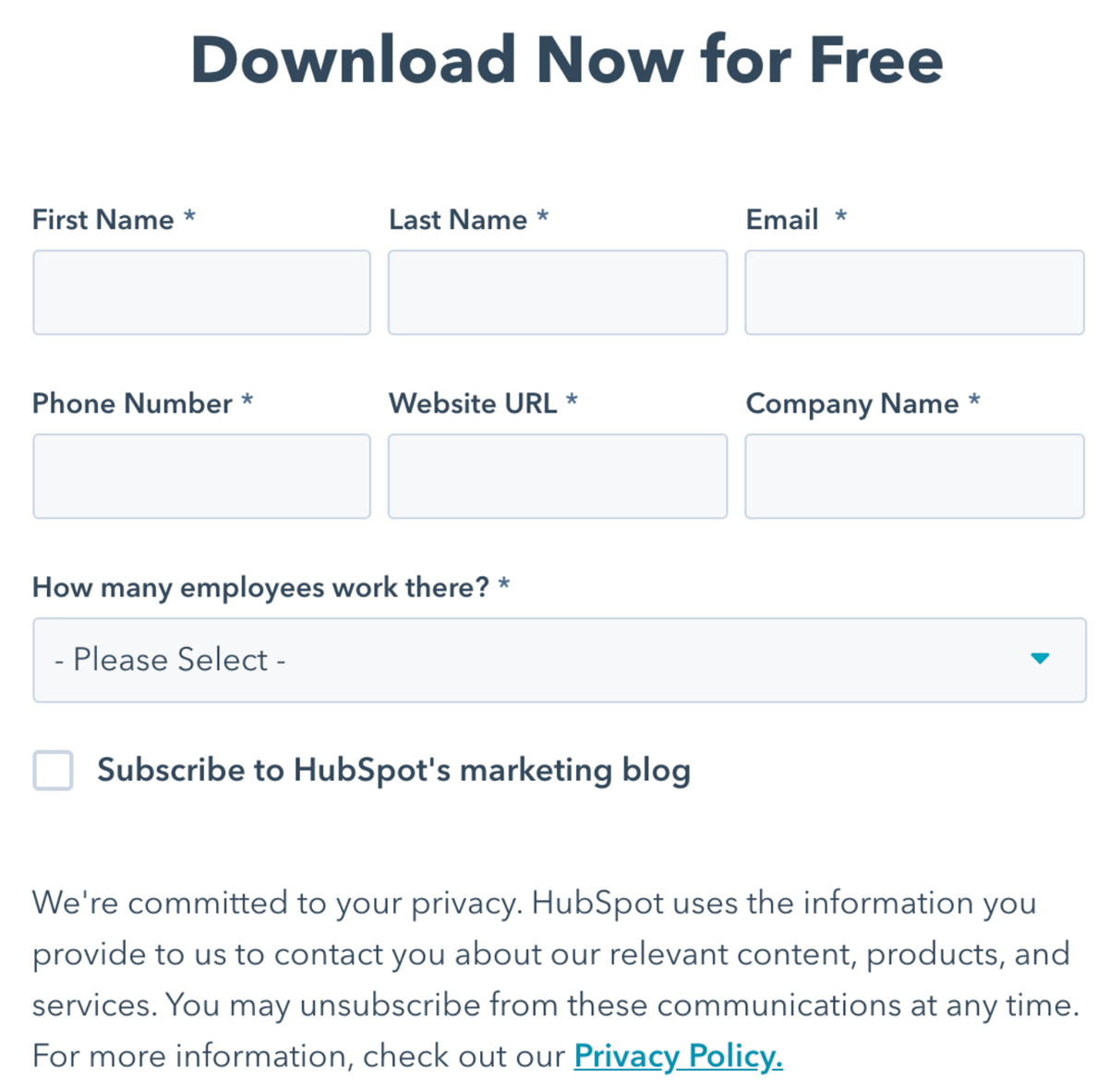
To cultivate the best relationship with your leads, build a thank-you page that'll display after filling out the opt-in form. This will not only make them feel appreciated but also tell them how to get the lead magnet. When you’ve successfully encouraged a person to give you their contact information, they’re officially in the bottom stage of the lead generation funnel, but you must show your appreciation and prevent them from slipping out.
An effective thank-you page will have the following:
While your thank-you page is used to make a good impression, also use it as an opportunity to motivate the lead to continue engaging with your content or to spread it. Include invitations to follow your social accounts, social share buttons, or refer-a-friend bonuses.
Before you begin investing marketing dollars or sales time into nurturing these leads, you must qualify them as a marketing qualified lead (MQL). This is usually done through quantitative lead scoring, which takes into account a lead’s demographics and behavior to assign them a score. Only leads with scores above a determined threshold (typically 80/100) are considered MQLs. Read our article on lead scoring to learn how to create one of these systems.
Examples of demographic or behavioral point values include:
It’s best practice to automate your lead scoring framework with a software platform. That way, your sales reps don’t have to manually update scores and instead focus on leads deemed sales-ready.
Read our article on lead scoring to learn how to create one of these systems step-by-step, as well as examples and top software tools to use.
Now that you've set up your funnel, it's time to distribute your awareness content so ideal leads can begin to learn about your brand or offering. Sometimes, this is determined by the content itself, like SEO content that ranks organically in Google. Other times, it's an act of sharing content across multiple platforms, such as sharing your SEO articles on social media to build an audience.
There are three main ways to distribute your awareness content:
It’s best to use a diversified approach to drive traffic to your content. That way, you’re reaching people with different web preferences. One potential buyer might love social media, while another only uses Google. Of course, reference the map of your lead journey to see where your highest quality leads are coming from. Which traffic source brings in the most customers? Invest the most in that type of traffic.
For more information on how to generate online leads using your lead generation funnel, check out our article on online lead generation. There, you'll find defined steps and strategies to actively generate online leads using the online lead generation funnel you created.
To make an outbound lead generation funnel, you'll map the interactions your leads have with your brand from initial outreach to qualification as a sales qualified lead (SQL), which typically occurs over a call. This type of funnel is only important to those with an outbound lead generation process — usually B2B or high-priced B2C products and services.
Here's an example of what an outbound lead funnel might look like:
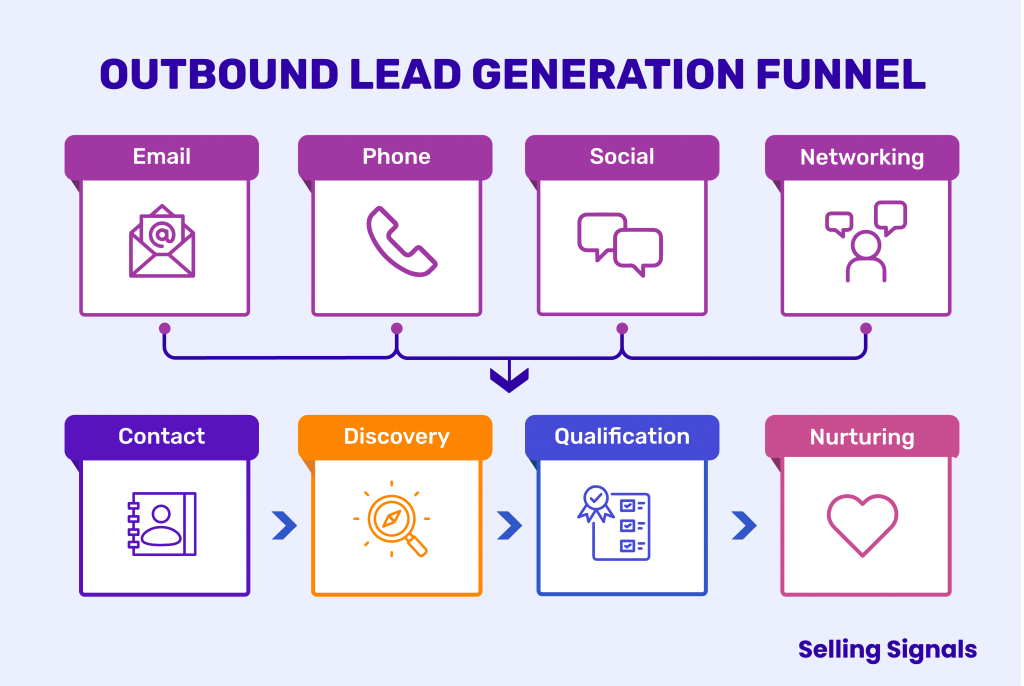
Specifically, these are the steps to follow when creating your outbound lead gen funnel:
First, define how you're going to generate manual leads and the stages necessary to get them on the phone. The two most typical ways to generate outbound leads are via cold calling or cold emailing, but can also include online engagement like LinkedIn.
Once you decide on the methods of outreach, define the required outreach stages. If you're cold emailing potential prospects, this might look like: Cold Email Outreach One > Cold Email Outreach Two > Cold Email Outreach Three > Quarterly Cold Lead Outreach. However, you might include other engagement methods, like engaging with them on social media between cold emails two and three.
Once you've defined your lead generation process stages, map those steps in your CRM software. This way, you can tangibly see your lead funnel as well as track and manage leads as they move through your outbound funnel.
The leads in the top stage of your outbound funnel will be those already on your prospecting list. The best way to ensure these people convert is to make them aware of your brand before reaching out directly. You’ll typically already have found their email addresses and phone numbers, either from buying the data from a lead database or from doing manual research.
Here are three ways to increase leads' awareness of your brand:
After a lead is sufficiently warmed up, shoot your shot with direct outreach. When you introduce yourself and state your company name, they’ll feel comfortable having heard of it, and therefore will be more open to listening to or reading what you have to say in your sales message.
Make the person interested in your product or service by reaching out to them directly. This first touch should focus on mentioning specific problems or frustrations they might be dealing with and informing them you have a solution to it.
Here are a few ways to directly reach out:
Building interest and desire may take a few cold outreaches before you get a positive response. So create a cadence of emails and calls that accounts for this. When the lead finally replies positively, it’s time to get them to take action.
After they’ve expressed interest, immediately call the lead to action by requesting a longer conversation. Explain what you hope to accomplish on the call: to learn more about their needs and assess fit. Your goal is to present the value of continuing the conversation with you.
After they’ve agreed to a time, send them a calendar invite with a message briefing them on what will occur in the meeting or on the call, and consider including any materials you'd like them to review beforehand if they have time. You could also upgrade the CTA by including a way for them to auto-schedule time with you for a short call via Calendly.
Now it’s time to ask this lead some questions to assess their level of fit with your product or service. Typically, sellers use a lead qualification framework, like BANT, where they ask questions to uncover details about a lead’s budget, authority, needs, and expected timeline. The lead’s answers are then weighed against those of typical customers. If they match, the lead is converted to an SQL, and they enter a sales pipeline for further nurturing.
The standard process for hosting a discovery call includes:
To get the most out of your discovery call meeting, it’s best practice to resist the urge to sell your solution and instead let your lead openly communicate their needs. The best way to do this is to be personable and ask open-ended questions. The more comfortable your leads are during the discovery call, the more information you can get to help qualify them.
To learn more, read our article on how to conduct a discovery call that effectively qualifies leads, where we give you concrete steps to follow as well as a downloadable template with sample questions.
For more information on how to use your outbound lead generation funnel to generate manual leads, check out our article on sales prospecting. There, you'll see the specific steps and strategies necessary to move outbound leads through your outbound lead generation funnel.
Once you've built your lead generation funnel, be sure to optimize it early and often by testing and tracking your funnel and conversions, prioritizing SEO, and relying on software. Doing so will increase the chances that the hard work you've put into the funnel pays off and results in high-quality leads that are fans of your brand and interested in your product or service. Here are a few specific ways to optimize your funnel:
Act as a lead and follow the funnel yourself. Ensure that your landing page is clean, your opt-in forms and thank-you page work properly, and your lead magnet is delivered seamlessly. Fix any hiccups that could affect your conversions.
If you offer free content to build brand awareness, ensure that your ideal leads see it when they search the topic on Google. Check out our article on SEO lead generation to learn how to do this.
After you've visualized your buyer journey and the creation of your funnel, choose all-in-one software to help you build it from the ground up.
Using your CRM, your lead gen funnel software, or the ad manager of the platform you use to run ads, track your conversions and other metrics that can determine whether your funnel is working properly or it's time to make some tweaks.
When creating and optimizing your lead generation funnel, use software such as a CRM, landing page builder, and/or lead generation funnel software whenever possible rather than doing it all manually. Next, we'll look at a few lead generation funnel software options that you can choose from.
One of the best ways to build an effective lead generation funnel is to use quality funnel software. The top lead generation funnel tools are all-in-one marketing platforms that help you build landing and thank-you pages, web forms, email drip campaigns, and other key components of a successful lead generation funnel. Some funnel software offer features specific to niche industries, such as abandoned cart management for ecommerce companies.
These are some of the best sales funnel software available for lead generation:
To choose the right lead generation funnel software for your business, first plan out your funnel using the steps we've laid out in this article. Then, ensure the software you're considering offers features to help you build and execute each part of the funnel. If you're comfortable with the price, features, and reviews, sign up for a trial or demo. Read our article on the top sales funnel software for a complete list of software with their pricing information and ideal use cases.
A lead generation funnel maps the adventure a person takes with your brand on their way to becoming a qualified lead, from where they come from, what content they see and interact with, to how they finally become qualified. A strong lead funnel will supply your reps with healthier pipelines filled with high-quality leads who trust and admire your brand. Now that you have the tools to implement a strong funnel, check out our guide on how to qualify leads the right way.


Sam is a former SaaS sales rep turned freelance writer. He spent his career selling real estate technology to C-suite executives before switching over to blogging, where he now covers sales, marketing, and small business topics. Sam specializes in lead generation, lead nurturing, and deal closing articles for Selling Signals. When he’s not researching the latest sales trends, he’s either penning short stories, hiking, or reading in NYC’s Washington Square Park.

Selling Signals delivers actionable advice for sales and marketing professionals. Learn strategies that help you hit targets, strengthen customer relationships, and win more business. Get expert advice on lead generation, sales processes, CRM software, sales management, and account management directly to your inbox.
Property of TechnologyAdvice. © 2025 TechnologyAdvice. All Rights Reserved
Advertiser Disclosure: Some of the products that appear on this site are from companies from which TechnologyAdvice receives compensation. This compensation may impact how and where products appear on this site including, for example, the order in which they appear. TechnologyAdvice does not include all companies or all types of products available in the marketplace.